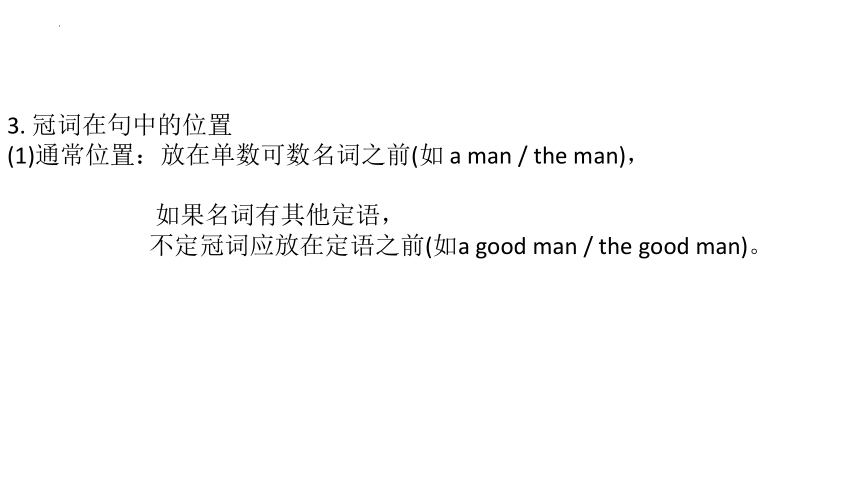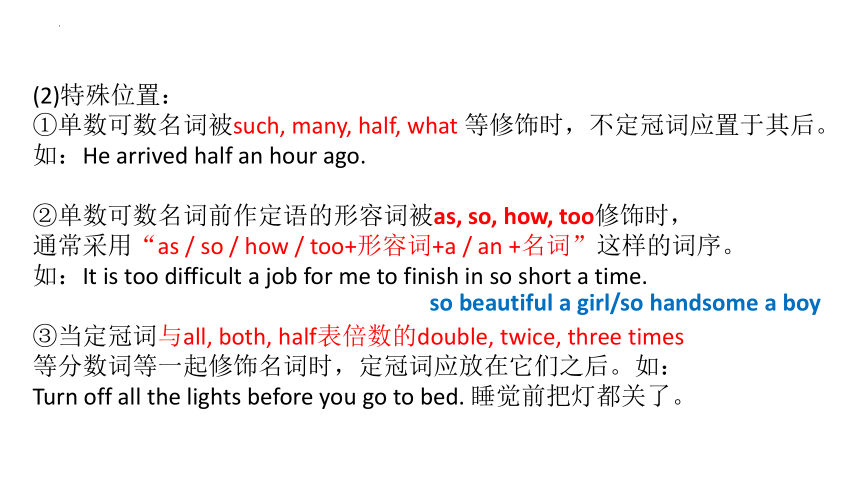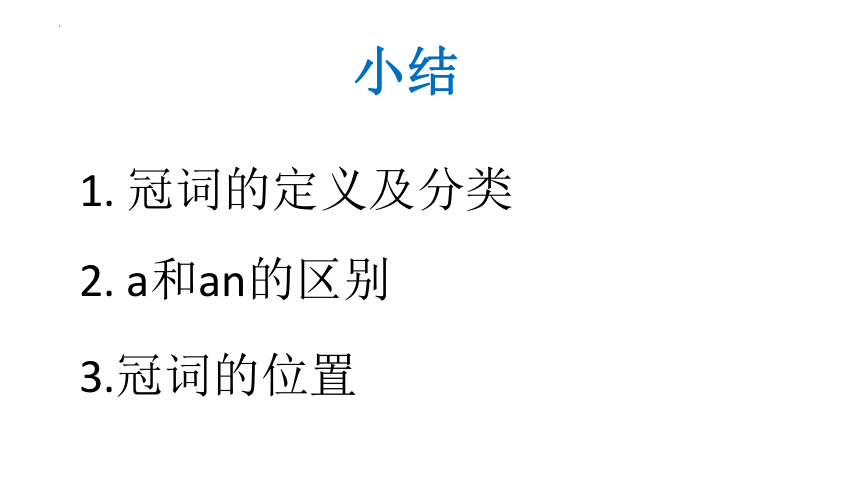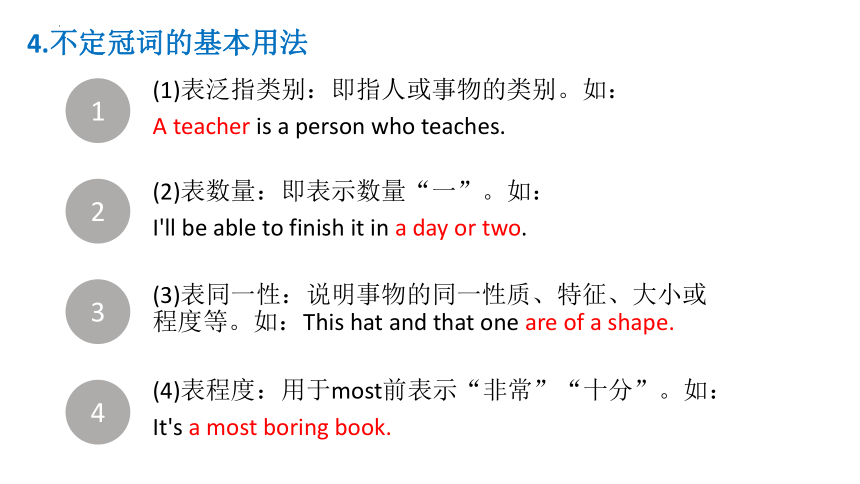2022届高考英语二轮专题:冠词用法课件(19张)
文档属性
| 名称 | 2022届高考英语二轮专题:冠词用法课件(19张) |  | |
| 格式 | pptx | ||
| 文件大小 | 123.8KB | ||
| 资源类型 | 教案 | ||
| 版本资源 | 通用版 | ||
| 科目 | 英语 | ||
| 更新时间 | 2022-06-05 20:30:55 | ||
图片预览







文档简介
(共19张PPT)
英语冠词用法
1.冠词是置于名词前并限定名词的意义的虚词。
不定冠词:a和an
定冠词: the
冠词的定义及分类
2. a与an的用法区别
(1)基本区别:原则上说,a用于辅音前;an用于元音前。
辅音前用a的例子如a book, a student, a school, a house等;
元音前用an的例子如an egg, an apple, an object, an idea等。
(2)易错说明:hour, honest, honor等单词
以辅音字母h开头,读音却以元音开头,因此,前面要用an。
以元音字母开头,读音却以辅音开头,应用a而不是an,
这些词常见的有useful, university, usual, one-eyed等。
一切以读音为准
3. 冠词在句中的位置
(1)通常位置:放在单数可数名词之前(如 a man / the man),
如果名词有其他定语,
不定冠词应放在定语之前(如a good man / the good man)。
(2)特殊位置:
①单数可数名词被such, many, half, what 等修饰时,不定冠词应置于其后。
如:He arrived half an hour ago.
②单数可数名词前作定语的形容词被as, so, how, too修饰时,
通常采用“as / so / how / too+形容词+a / an +名词”这样的词序。
如:It is too difficult a job for me to finish in so short a time.
③当定冠词与all, both, half表倍数的double, twice, three times
等分数词等一起修饰名词时,定冠词应放在它们之后。如:
Turn off all the lights before you go to bed. 睡觉前把灯都关了。
so beautiful a girl/so handsome a boy
小结
1. 冠词的定义及分类
3.冠词的位置
2. a和an的区别
1
2
3
4
(1)表泛指类别:即指人或事物的类别。如:
A teacher is a person who teaches.
(2)表数量:即表示数量“一”。如:
I'll be able to finish it in a day or two.
(3)表同一性:说明事物的同一性质、特征、大小或程度等。如:This hat and that one are of a shape.
(4)表程度:用于most前表示“非常”“十分”。如:
It's a most boring book.
4.不定冠词的基本用法
1
2
3
4
(1)用于序数词前:表示“再一”“又一”。如:
Shall I ask her a third time
(2)用于由动词转化来的名词前:表示一次(通常与 have, take, make, give 等动词连用)。如:We’ve already had a try at it.
(3)用于专有名词前:意为“一个”“某个”。如:
The house next door has been bought by a Mr Jones.
(4)用于抽象名词前:表示与该之相关的具体的人或事。如:
He was a success in business.
5.不定冠词考点性用法
小结
1.不定冠词基本用法(4个)
2. 不定冠词考点性用法(4个)
1
2
3
4
表示特指:特指某(些)人物(包括用于上文提到过的人或物之前,以及说话双方都知道的人或物)。如:We have a cat and two dogs. The cat is black and the dogs are white.
表示独一无二:用在世界上“独一无二”的事物的名词前。如:
The earth goes round the sun. 地球绕着太阳转。
用于最高级前:即用于形容词或副词的最高级前。如:
Who picked the most apples 谁摘的苹果最多
用于序数词或方位词之前。如:
He was the first man to think of it. 他是第一个想到这一点的人。
6.定冠词的基本用法
5
6
7
8
用于乐器名词前:表示相应乐器的演奏。如:
Besides the violin, he plays the piano and the flute.
表示人体部位:用于某些介词短语中指身体的某个部位。如:
He patted me on the back.
用于表示一家人:用于在姓氏的复数形式之前表示一家人或夫妇二人。如:The Smiths live in the apartment above ours.
用于江河湖海等前:用于江河湖海、山脉群岛、海湾海峡等地理名词前。如:The Yellow River flows into the Yellow Sea.
6.定冠词的基本用法
用于某些含有普通名词的专有名词前:
用于某些国名、组织机构、建筑物、报纸杂志、会议条约等
含有普通名词与其他词构成的专有名词。
如:
We visited the Great Wall yesterday. 我们昨天去参观了长城。
9
1
2
3
4
用于整十的复数数词前:表示几十年代。如:
This happened in the seventies. 这发生在七十年代。
用于比较级前:用于“the+比较级,the+比较级”结构中表示“越……就越……”。如:The sooner we operate now the safer.
用于表示类别:用于“the+某些形容词或过去分词”中表示一类人。如:
Do you think the rich should pay more taxes to help the poor
用于国籍名词前表总称:用于“the+某些国籍的形容词”中表示某国人的总称。
如:The French are famous for their food.
7.定冠词的考点性用法
5
6
7
用于集合名词前表总称:用于“the + police / public等集合名词”中表示这类人的总称。如:The police are looking for the murderer. 警察正在寻找那个凶手。
用于修饰same, only, very等形容词:即用于“the same / only / very +名词”结构中。如:That’s the only reason. 那是唯一的理由。
用于单位:即用于“单位词”(hour, day, month, year, dozen, gallon, ton, yard等)前表示标准,汉语的“按”。如:They let out cars by the day.
但是如果量词为不可数名词,by weight(按重量)习惯上不用冠词。如:Bananas are usually sold by weight. 香蕉通常按重量卖。
7.定冠词的考点性用法
小结
1.定冠词基本用法(9个)
2.定冠词考点性用法(7个)
1
2
3
4
表泛指的不可数名词或复数名词前。如:
Snow was falling. 正在下雪。
倒装的让步状语从句中:在as(虽然)引导让步状语从句前面的单数可数名词前不用冠词。如:Child as he was, he knew how to help others.
某些特殊词前:例如在man,nature,space,society, word(消息)的前面不用冠词。如:Man is a rational animal.
独立主格结构中:在表示伴随或补充说明用用的独立主格结构中,名词前不用冠词。如:The teacher came in, book in hand.
零冠词的情况:
5
6
7
8
表示职位、身份、头衔的名词作表语、补足语和同位语,以及表示季节年份日期的名词前
Trump, elected president of USA , is an interesting person.
学科、球类、棋类,游戏名词前
多数特有名词的街道,桥梁,广场,车站,公园等
固定搭配have diffictulty/trouble in doing sth等
9
10
“(a) kind [sort] of+名词”结构的“名词(type,sort,species)”前:
该结构中的“名词”不管是单数还是复数,
其前都通常用零冠词。如:This kind of book is very interesting.
表抽象意义的单数名词前:当单数可数名词含义抽象化
意味时,通常用零冠词。如:I was fool enough to accept his offer.
零冠词的情况:
小结
零冠词用法(10个)
英语冠词用法
1.冠词是置于名词前并限定名词的意义的虚词。
不定冠词:a和an
定冠词: the
冠词的定义及分类
2. a与an的用法区别
(1)基本区别:原则上说,a用于辅音前;an用于元音前。
辅音前用a的例子如a book, a student, a school, a house等;
元音前用an的例子如an egg, an apple, an object, an idea等。
(2)易错说明:hour, honest, honor等单词
以辅音字母h开头,读音却以元音开头,因此,前面要用an。
以元音字母开头,读音却以辅音开头,应用a而不是an,
这些词常见的有useful, university, usual, one-eyed等。
一切以读音为准
3. 冠词在句中的位置
(1)通常位置:放在单数可数名词之前(如 a man / the man),
如果名词有其他定语,
不定冠词应放在定语之前(如a good man / the good man)。
(2)特殊位置:
①单数可数名词被such, many, half, what 等修饰时,不定冠词应置于其后。
如:He arrived half an hour ago.
②单数可数名词前作定语的形容词被as, so, how, too修饰时,
通常采用“as / so / how / too+形容词+a / an +名词”这样的词序。
如:It is too difficult a job for me to finish in so short a time.
③当定冠词与all, both, half表倍数的double, twice, three times
等分数词等一起修饰名词时,定冠词应放在它们之后。如:
Turn off all the lights before you go to bed. 睡觉前把灯都关了。
so beautiful a girl/so handsome a boy
小结
1. 冠词的定义及分类
3.冠词的位置
2. a和an的区别
1
2
3
4
(1)表泛指类别:即指人或事物的类别。如:
A teacher is a person who teaches.
(2)表数量:即表示数量“一”。如:
I'll be able to finish it in a day or two.
(3)表同一性:说明事物的同一性质、特征、大小或程度等。如:This hat and that one are of a shape.
(4)表程度:用于most前表示“非常”“十分”。如:
It's a most boring book.
4.不定冠词的基本用法
1
2
3
4
(1)用于序数词前:表示“再一”“又一”。如:
Shall I ask her a third time
(2)用于由动词转化来的名词前:表示一次(通常与 have, take, make, give 等动词连用)。如:We’ve already had a try at it.
(3)用于专有名词前:意为“一个”“某个”。如:
The house next door has been bought by a Mr Jones.
(4)用于抽象名词前:表示与该之相关的具体的人或事。如:
He was a success in business.
5.不定冠词考点性用法
小结
1.不定冠词基本用法(4个)
2. 不定冠词考点性用法(4个)
1
2
3
4
表示特指:特指某(些)人物(包括用于上文提到过的人或物之前,以及说话双方都知道的人或物)。如:We have a cat and two dogs. The cat is black and the dogs are white.
表示独一无二:用在世界上“独一无二”的事物的名词前。如:
The earth goes round the sun. 地球绕着太阳转。
用于最高级前:即用于形容词或副词的最高级前。如:
Who picked the most apples 谁摘的苹果最多
用于序数词或方位词之前。如:
He was the first man to think of it. 他是第一个想到这一点的人。
6.定冠词的基本用法
5
6
7
8
用于乐器名词前:表示相应乐器的演奏。如:
Besides the violin, he plays the piano and the flute.
表示人体部位:用于某些介词短语中指身体的某个部位。如:
He patted me on the back.
用于表示一家人:用于在姓氏的复数形式之前表示一家人或夫妇二人。如:The Smiths live in the apartment above ours.
用于江河湖海等前:用于江河湖海、山脉群岛、海湾海峡等地理名词前。如:The Yellow River flows into the Yellow Sea.
6.定冠词的基本用法
用于某些含有普通名词的专有名词前:
用于某些国名、组织机构、建筑物、报纸杂志、会议条约等
含有普通名词与其他词构成的专有名词。
如:
We visited the Great Wall yesterday. 我们昨天去参观了长城。
9
1
2
3
4
用于整十的复数数词前:表示几十年代。如:
This happened in the seventies. 这发生在七十年代。
用于比较级前:用于“the+比较级,the+比较级”结构中表示“越……就越……”。如:The sooner we operate now the safer.
用于表示类别:用于“the+某些形容词或过去分词”中表示一类人。如:
Do you think the rich should pay more taxes to help the poor
用于国籍名词前表总称:用于“the+某些国籍的形容词”中表示某国人的总称。
如:The French are famous for their food.
7.定冠词的考点性用法
5
6
7
用于集合名词前表总称:用于“the + police / public等集合名词”中表示这类人的总称。如:The police are looking for the murderer. 警察正在寻找那个凶手。
用于修饰same, only, very等形容词:即用于“the same / only / very +名词”结构中。如:That’s the only reason. 那是唯一的理由。
用于单位:即用于“单位词”(hour, day, month, year, dozen, gallon, ton, yard等)前表示标准,汉语的“按”。如:They let out cars by the day.
但是如果量词为不可数名词,by weight(按重量)习惯上不用冠词。如:Bananas are usually sold by weight. 香蕉通常按重量卖。
7.定冠词的考点性用法
小结
1.定冠词基本用法(9个)
2.定冠词考点性用法(7个)
1
2
3
4
表泛指的不可数名词或复数名词前。如:
Snow was falling. 正在下雪。
倒装的让步状语从句中:在as(虽然)引导让步状语从句前面的单数可数名词前不用冠词。如:Child as he was, he knew how to help others.
某些特殊词前:例如在man,nature,space,society, word(消息)的前面不用冠词。如:Man is a rational animal.
独立主格结构中:在表示伴随或补充说明用用的独立主格结构中,名词前不用冠词。如:The teacher came in, book in hand.
零冠词的情况:
5
6
7
8
表示职位、身份、头衔的名词作表语、补足语和同位语,以及表示季节年份日期的名词前
Trump, elected president of USA , is an interesting person.
学科、球类、棋类,游戏名词前
多数特有名词的街道,桥梁,广场,车站,公园等
固定搭配have diffictulty/trouble in doing sth等
9
10
“(a) kind [sort] of+名词”结构的“名词(type,sort,species)”前:
该结构中的“名词”不管是单数还是复数,
其前都通常用零冠词。如:This kind of book is very interesting.
表抽象意义的单数名词前:当单数可数名词含义抽象化
意味时,通常用零冠词。如:I was fool enough to accept his offer.
零冠词的情况:
小结
零冠词用法(10个)
